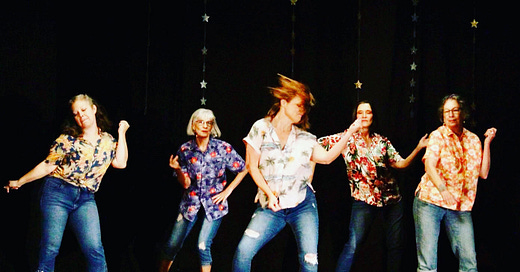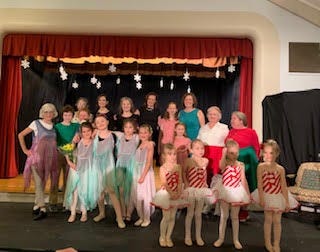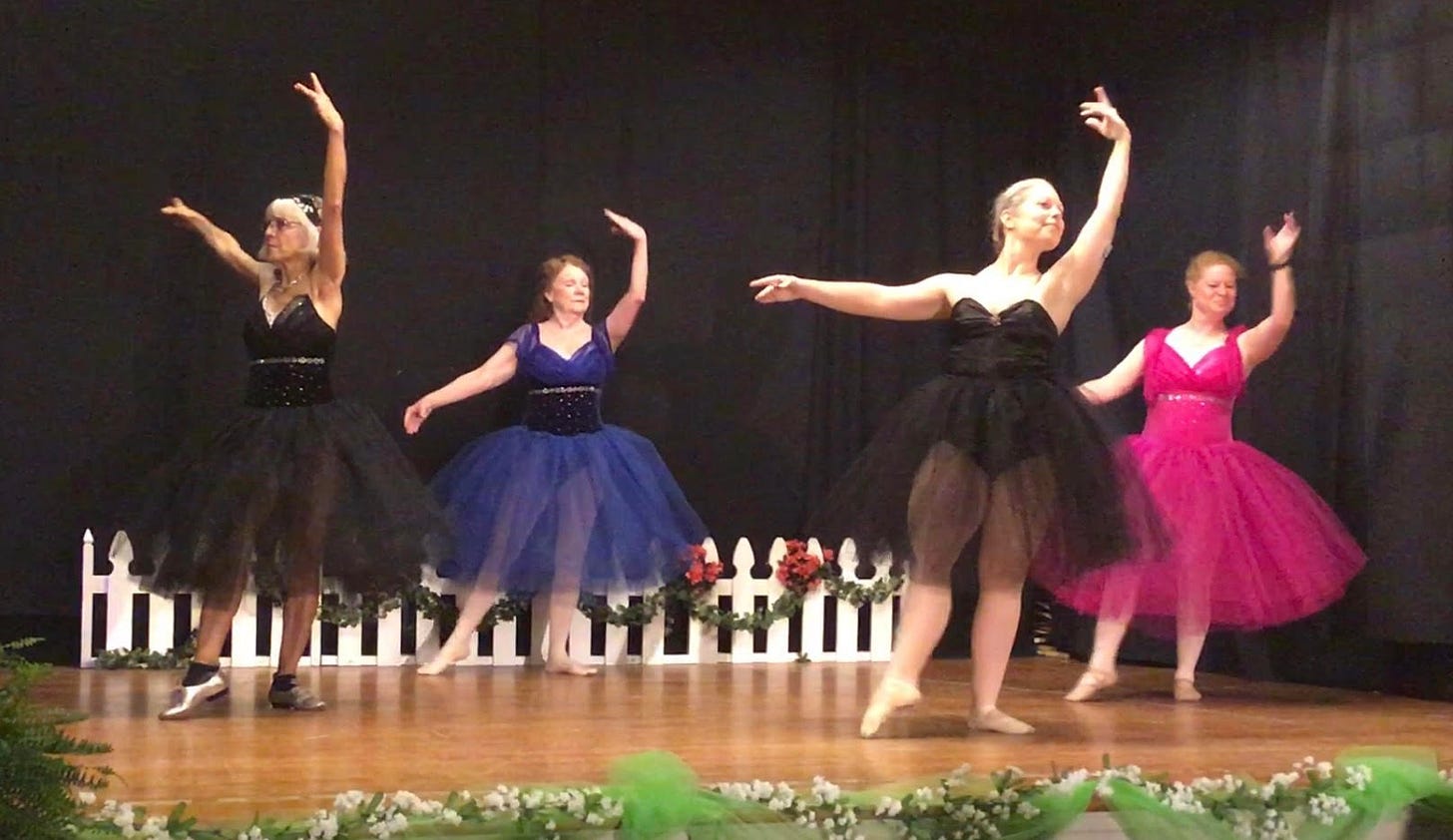The Joy Ensemble: Community Dance in Chattanooga
An ensemble committed to all-ages instruction, performance, and service
Welcome!
You’re reading DanceChatt, a publication for reflective writing about dance in and around Chattanooga. In this issue we visit The Joy Ensemble, where dancers of all ages learn, perform, and serve together.
As companies announce more fall performances, DanceChatt wants to cover … all of them! But I need your help. If you know of an upcoming performance, let me know! Maybe you’d like to visit as audience member and write a review. Maybe you’re a dancer or choreographer and you have insights into the process of creating your work. Whatever your perspective, the community would love to hear your voice.
The Joy Ensemble: Community Dance in Chattanooga
By Jenn McCormick
Photos courtesy of Margaret Sikes
I … encouraged all to keep adapting the movement so that even as many of us stood up, others could continue seated. I realized that the participants were learning theme and variation in this way; when I posed all of this as artistic practice, the participation level soared. What became evident to me is that conventional technique classes assume that every student’s body will work at the same pace as the teacher’s. (For example, I’ve known many dancers who come to class early to warm up so that they will be ready for the teacher’s warm-up, making clear the inaccuracy of this assumption.)
— Liz Lerman, Hiking the Horizontal
In this city — maybe in other places — we grapple with the concept of community dance. Everyone should dance, we say. And rightly. Also: Those who desire professional training and experience should have access to those things. Right, again. But then there’s the problem of fitting the pieces together.
What if we want to teach, create dances for, or participate in dances with:
Dancers who must remain seated and dancers who stand?
Dancers in active professional training and dancers with sporadic or informal training?
Child dancers and adult dancers?
Young adult dancers and elder dancers?
How do we approach such projects with artistic and spiritual seriousness? What does that approach look like?
Margaret Sikes, founder, director, and CEO of The Joy Ensemble, studied under teachers from Liz Lerman’s Dance Exchange while at American Dance Festival in North Carolina. There, she participated in investigative dance work, sharing the art and creating works in collaboration with groups in the community.
“We went and worked with pregnant teen moms, people with multiple sclerosis,” Margaret recalls. “We would create projects with them.”
In Chattanooga, years later, she wanted to recreate that experience. A studio closure gave her the opportunity to start her own company.
“I wanted to bring people together,” she says. “It’s not just about teaching tap or ballet, though that gets people into the studio. It’s something to build on. Even if I were to quit giving classes altogether, I would still do that community work.”
So, in 2020, The Joy Ensemble was born. Though the first class was a tap class, the ensemble also teaches ballet and has taught modern dance. Margaret draws on her experience teaching children and also her years instructing older adults at the YMCA.
“Our mission is to bring people of all ages and abilities together to dance, create, and serve others,” she says.
In the ensemble, people of all ages take classes together. And as Liz did in her various projects, Margaret and The Joy Ensemble dancers bring the art into the community, focusing on the needs of youth, adults, and elders while holding intergenerational classes and performances. In the midst of a Golden Tap class and a couple of age-grouped classes for young children, the schedule offers the bulk of classes for ages 10–adult — potentially a 90-year span among students. Four multi-generational families currently dance with the ensemble, some spanning three generations.
In the studio
In that moment, I realized I had stumbled into a weird and wondrous laboratory. Suddenly, everything I believed in was called into question — especially everything that I believed about how to train a person to become a dancer. What exercises did these folks need? How and what could I ask them to achieve? What would good technique mean on an eighty-year-old body? What made them look beautiful? … I began to question accepted notions of who and what was beautiful.
— Liz Lerman, Hiking the Horizontal
When I visit a Joy Ensemble tap dance class in late August, people are just reassembling after summer vacations and the hustle of school start-up. The company holds class in a cozy building on the campus of St. Luke United Methodist Church. Inside the cement block structure is a ceiling of exposed wooden beams. Paper flowers. Fairy lights. A row of mirrors on stands divides the room into a waiting area and a studio space.
This evening, Emily Sapere, professional dancer, teacher, and choreographer with a long resume in commercial dance, is giving tap class. At first she has two students — a girl who looks like a preteenager and a woman, Sherri DeRose, who later tells me she’s 74. Margaret, who has just finished teaching the previous class, bids other students goodbye and gets into her tap shoes.
Eventually there are three students, representing community dance in a microcosm. The girl, earnest and glowing with thought. Margaret, the professional dancer and company founder, keeping up her technique and participating in her community between teaching and administrative duties. Sherri, smiling but intensely focused, getting everything she can out of the class after 30 years as an adult dancer.
It’s my first time watching a tap class. Music pumps. The students wear street clothes — bright shorts and tee-shirts. Everyone faces the mirror and they all warm up together. There’s no explain — mark — full out pattern you find in a ballet or modern class. Until they get to the tougher sequences far along in class, everyone does everything at once, the teacher calling counts and cues.
They go faster and faster. When someone stumbles into confusion, Emily has them repeat it. “Let’s go over that a minute because I think you guys can do that!”
The pedagogy combines a bright assumption of competence with a word or two of instruction geared toward each student’s needs. On staying balanced: “Tap dancing is making music with our feet, but dancing itself is just transferring weight.”
She illustrates how the movement of the shoulders leads into the weight transfer. For the younger student, this is artistic instruction. For the older woman, the same words are a guide to performing the steps safely. I’m excited by the economy of spoken instruction, distracting very little from the constant motion of the class.
“Let me hear,” Emily says, over and over. Not “let me see.”
The floor snaps and shouts under them — a joyful sound. Margaret later explains that the sprung floor is pressboard over pool noodles. She resurfaces it a couple of times a year.
They move from simple to complex combinations adding arms, then building to traveling steps. In between, they compliment each other’s clothes or ask about a vacation or a family member, but briefly. Everyone’s focused. Intent.
I watch the difference in Emily’s approach to her three students. She corrects the first sign of error in the young student, and promptly remarks when she gets something right. Also, she touches her a couple of times — brief, brisk touches for correction or encouragement.
The older student she gives more detailed explanations to, but only when asked. I watch the older student repeat a combination several times, not matching the demonstrated steps at first, then getting closer with each pass until she has it. She doesn’t need immediate correction because her mind is teaching her body, using repetition as the corrective. Getting it, for her, is as much an internal process as a receptive process, I think. Emily hasn’t said much to her, but she’s been watching. “Beautiful, Sherri!” she says as the combination now shines fully through Sherri’s body.
“During our day classes, our median age might be 60,” Margaret tells me after class. “About 80% of our day students are older than 60.”
Some instructions are modified for older students, Margaret explains. For instance, many older people never stand fully on the ball of the foot. The steps are there but don’t allow the heavy heel drop common in tap dance. Instead, the dancers use what Margaret calls “ghost heel,” just off the floor, to help those with limited balance feel weight transitions safely.
Choreography may also take longer to learn, or need to be broken down into small sections, she adds. But the process is worth it. Dance — and especially tap, research has shown — builds synapses in the brain, improving memory.
And, Margaret adds, dancers may want the teacher always to dance with them.
“But in the end,” she adds, “the teacher has to stand back to make the students dance without them. They don’t like it, but it has to be done.”
Sherri explains that she began as an adult student 30 years ago, but never could find a class that didn’t break up. It’s not a complaint — it’s simply the exigency of having children, grandchildren, jobs, aging parents — we all know that. But it makes it hard to follow the art.
“When I moved to Tennessee eight years ago, I went from one class to another,” Sherri says. After finding The Joy Ensemble, she’s taken from notable Chattanooga professionals and instructors including Emily Sapere and Lindsay Fussell, she says.
“How have you changed as a student across 30 years?” I ask. “What have you learned about yourself?”
Sherri smiles.
“That eventually I’ll get it,” she says. “It will all fall into place.”
In the community
In 1975 … the idea of old people dancing was quite outlandish to most people. But for me it was the only choice I had.
—Liz Lerman
Dance instruction in older communities has numerous benefits, Margaret explains. “Associating a movement with a memory is really conducive to recall.”
Many people, she adds, take dance classes for a few years as children, then return as older adults. Others could never afford dance lessons.
I think back to Louie Marin-Howard’s description of a childhood where every kid could get at free dance instruction in the public schools. One way of letting everyone dance. Another is this: affordable, all-ages companies, similar to open-admissions colleges, offering people of any age the chance not only to take classes but to perform and serve others through dance.
At The Joy Ensemble, service starts with the ensemble itself, in which the community is invited into an act of storytelling — “a story through movement,” Margaret says — with each performance. Another act of service is Dances for Donation, in which class admission is a food donation for the Red Bank Food Pantry.
Beyond that, Margaret is on the lookout to create dance together with groups throughout the community. In November 2020, The Joy Ensemble partnered with Dominion Senior Living to teach a regular class, then develop movement-based stories together.
“We went as a studio and created with them,” Margaret says. “We started with their memories — often family times or trips together — and put movement with their ‘microstories.’ Everyone would perform.”
Seeing older dancers also involves benefits — especially for an audience of older adults. Sherri and other older dancers at The Joy Ensemble perform at recitals with the younger students.
They also perform in community venues.
“Last year I was chosen to perform at Seniors Got Talent at Morning Pointe [assisted living],” Sherri says. She didn’t take up the opportunity, “but I might try to do it another time.”
In fact, older dancers draw the eye. It’s compelling, as Lerman writes, to watch an elder dancing with “fury, athleticism, and tenderness.” But why?
For Sherri, it’s the projection of hope.
“How wonderful that people of an older age are still dancing,” she says. “It never leaves you.”
When I ask Margaret the same question, she answers, “People who are older can project emotion more. Even if the movement is not as fluid or athletic as a 20-year-old might be, they bring some kind of emotion, some kind of story to their movement.”
Luckily for us, elder dancers and all-age ensembles are flourishing all around us. We just have to keep our ears and eyes open for those stories.
Learn more about The Joy Ensemble
You can next see The Joy Ensemble at St. Luke UMC on Nov. 19 at 3 p.m.
Watch the Golden Tappers in action. Or take a class — the first class is free.
About the author
Jenn McCormick is a writer, editor and dancer working in Chattanooga. She is the publisher and managing editor of DanceChatt.
Join the Chatt
Join the conversation! If you’re interested in writing for DanceChatt, send a pitch email to jennelisewebster@gmail.com.
Until then, keep dancing.
— Jenn McCormick





